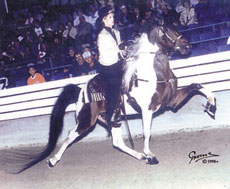|
Return
to Breed Profiles Main Page
Spotted Saddle Horse
"The Equine Sports Model"
What's flashy, smooth-riding, loaded with "chrome", and has plenty of horsepower? A sports car, of course! Throw in four legs, a mane and tail, and you must be talking about a Spotted Saddle Horse. 
Gaited, spotted horses have long been a favorite of horsemen with an eye for the extraordinary. As a "breed", Spotted Saddle Horses trace back to pinto colored ponies of Spanish and/or Nordic origins. In Tennessee, these ponies were crossed over the years, with local, gaited stock. The resulting horses were originally used as all-around family mounts that could cover ground comfortably for hours on end, then dazzle the competition at shows with their abilities and flashy appearance. They continue to thrive on temperament, gait, beauty and versatility.
Colorful Bloodlines
Several other breeds have been introduced into the colorful lineage of these horses, for one purpose or another. Standardbreds contributed size, speed and lateral gaits. Mustangs added more color and hardiness. Missouri Fox Trotters and Racking Horses, which share a common ancestry with Walking Horses, have influenced type and gait. Even Peruvian Pasos and Paso Finos have contributed in recent years. Consequently, horses registered as "Spotted Saddle Horses" vary significantly from one another, both in body type and gait.
Regardless of ancestry, the Spotted Saddle Horse is easily recognized, by its pinto coat and easy gait. The "spotted" criteria requires each horse to have white above the hocks (exclusive of facial markings), though registries recognize solid colored horses for identification purposes. In addition, the horse must perform a "saddle gait", be it a running walk, fox trot, rack, stepping pace, or similar Paso gait.
Though there is currently no uniform conformation standard, in general, Spotted Saddle Horses range from 14.3 to 16 hands and weigh from 900 to 1100 pounds. Long, sloping hips and shoulders, common to smooth-gaited horses, are preferred, as is a fairly short back. The top line should appear shorter than the bottom line as this contributes to a long, smooth stride. Generally athletic in build, some lines still reveal the pony-type origins in a short-coupled, compact, sturdy body, with a somewhat coarse head and legs, while others exhibit more refined characteristics.
Not surprisingly, breed fanciers are split between the "true" old-type Spotted Saddle Horse, that generally didn't stand much over 14 hands and a trend towards a Walking Horse build and gait. As a result, there are several breed associations devoted to pinto, gaited horses, each with a slightly different slant.
The Registries
The first registry to maintain records on Spotted Saddle Horses was the National Spotted Saddle Horse Association, (NSSHA) established in 1979, in Murfreesboro, TN. With 15 founding members, the new registry recognized 550 horses as their foundation stock. Sires, Fireball (SHF-1) and Tony W (SHF-2), are credited with likely having produced more spotted foals than any other stallions. NSSHA strives to establish a uniform breed saddle horse that naturally performs is gaits without extreme training techniques.

In l985, Mack Motes, one of the NSSHA founders, established the Spotted Saddle Horse Breeders and Exhibitors Association (SSHBEA), in Shelbyville, TN. His stallion, Scout's Mountain Buck M. (F85-1), became the first SSHBEA foundation sire. Under the auspices of SSHBEA, the evolution of the breed is evident in the individuals chosen as World Grand Champion. The first WGC in 1985, Lightening K, exemplified the Spanish/pony style, in both conformation and gait, while more recent winners, including the reigning, 1999 WGC, Hy-Tone Dancer, look decidedly more "Walking Horse".
Since the founding of these registries, more than 30,000 horses have been registered between the two. With the recent (Jan. 1, 1999) closing of half of the SSHBEA books, it is now a requirement that the one parent be registered to register offspring.
Another association, the Spotted Saddle Horse Association of the West (SSHAW) was recently established to preserve the versatility of the breed. Their Performance of Gaits and Judging Criteria were adopted by Friends of the Sound Horse (FOSH), in efforts to judge all Spotted Saddle Horses fairly, regardless of background or natural gait. The American Spotted Horse Association also seeks to preserve and standardize the breed.
For more information visit
these Spotted Saddle Horse Associations:
National Spotted Saddle Horse Association
P.O. Box 898
Murfreesboro, TN 37133-0898
Phone: (615) 890-2864
E-mail: [email protected]
Website: www.dnj.com/spothorse
Spotted Saddle Horse Breeders & Exhibitors Association
P.O. Box 1046
Shelbyville, TN 37162
Phone: (931) 684-7496
E-mail: [email protected]
Website: www.sshbea.org
The American Spotted Horse Association
P.O. Box 36
Manchester, TN 37349
Website: www.cafes.net/j/asha.htm
The Spotted Saddle Horse Association of the West
P.O. BOX 3474
Quail Valley, CA 92587
Phone: (909) 244-7150
E-mail: [email protected]
Website: www.geocities.com/Heartland/Ranch/9843/
|

